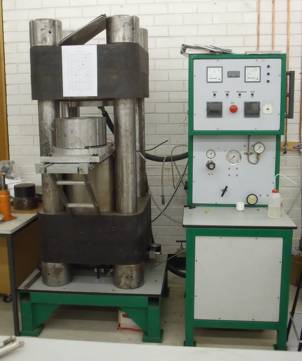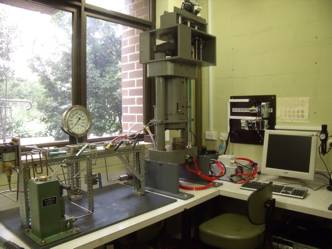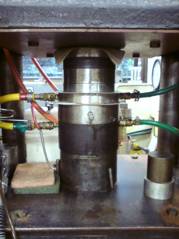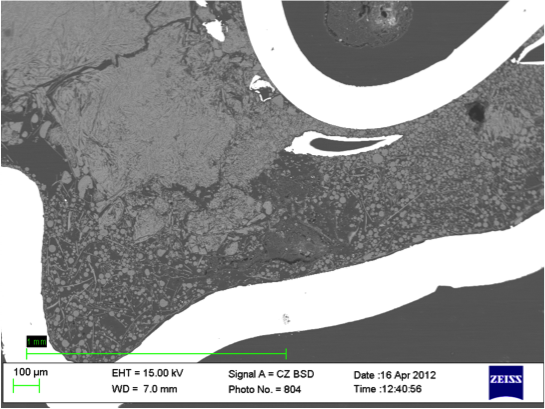GEMOC EARTH AND PLANETARY SCIENCES EXPERIMENTAL PETROLOGY/ROCK DEFORMATION GROUP
Members: Dr. Tracy Rushmer
Dr. John Adam
Dr Simon Clark
Raul Brens
We use a range of high-pressure and high-temperature hydrostatic and deformation equipment to investigate chemical and structural igneous rock-forming processes and metamorphic problems under a variety of conditions. Our overall aim is to understand major differentiation events that have shaped our planet. We are investigating both location-specific igneous rock-forming processes, clarifying ongoing problems in the Earth Sciences regarding crystalline rock genesis, partial melting, granitic magma formation and crustal differentiation both now and in the Archaean. We also work to determine experimental phase relations and element partitioning behaviour in simple systems of geological importance. This website will give you an overview of ongoing research projects, past applications of our work, and will start by taking you through the facilities we employ in our state-of-art laboratories.
National high-pressure facilities
The development of the D-DIA (a deformation mulit-anvil high pressure and temperature apparatus) for in-situ synchrotron experimentation has opened up the possibility of determining physical and chemical processes in the lower crust and upper mantle down to the upper transition zone in the Earth’s mantle. The upper mantle is the source of almost all magmas. It contains major transitions in rheological and thermal behaviour that control the character of plate tectonics and the style of mantle dynamics. We are currently building: 1) a D-DIA to perform high pressure multi-anvil experiments on the Australian synchrotron. The D-DIA apparatus has been very successfully used in the synchrotron facilities in the USA. Specifically at HPCAT and GESCARS Advanced Photon Source (APS), Argonne National Laboratory, USA and at National Synchrotron Light Source, Brookhaven National Laboratory (X17B2); and 2) to bring a modified D-DIA style mulit-anvil apparatus to the ANSTO/OPAL neutron facility in order to complement x-ray information with neutron scattering techniques, allowing light elements to be explored.
Macquarie Facilities: two laboratories containing a Griggs Rig, four piston-cylinder apparatus, a multi-anvil press, two drop-quench cylinder furnaces, a one atmosphere gas-mixing furnace, precision welding tools, high-precision weighing scales, and two box ovens. Sample preparation facilities are also included in the laboratories; opening, mounting, polishing and carbon coating of experimental run products can be achieved within hours of a run finishing, with the run product ready for further analysis.
| Griggs Rig: This equipment now has a state-of-the-art automated system, able to investigate the strength of rocks as they are deformed. The Griggs Rig is a piston-cylinder rock deformation apparatus which uses axial compression to subject rocks to conditions where they will behave in a ductile manner. Experimental capabilities are in the range of 5-25 kbar and between 700 to 1100 °C. Such conditions are analogous to those found in the mid to lowermost continental crust/upper mantle in areas which are notoriously hard to study directly. With this equipment, we are able to: study the rheology of geologic materials and deformation mechanisms in the continental crust, study deformation mechanisms in partially molten rock (and their mechanical behaviour), and investigate the interaction between deformation and metamorphism. We are able to produce stress/strain, deformation and fracture models for all types of rock, which has applications for important societal hazards such as fault zones. Current collaborative projects using this apparatus include metal-silicate segregation and migration, fluid flow and HSE partitioning between metallic liquid and solid (Tracy Rushmer). |
|
|
Piston-cylinder press in action |
Capsule showing results of high pressure – high fluid |
Piston-cylinder apparatus: This equipment is used to measure the fundamental properties of silicate melts (pressure, temperature, H2O effects), and the kinetics of mineral-melt-fluid reactions. Our piston-cylinder apparatus is end-loaded, using a bottom ram to apply the primary load, then a top ram above a piston to amplify the pressure put on the larger area as it is focussed onto the smaller piston. The apparatus uses ½ or ¾ inch pressure cells, contained within a water-cooled tungsten carbide core surrounded by steel for support (see photo above left). The sample set up comprises a 2 mm capsule (most often an alloy of Ag-Pd) filled with the required start material, ±H2O, within a graphite furnace and then a deformable talc cell. High temperature is achieved by passing a current through the graphite furnace, with temperature measured by a thermocouple. |
In this way, we can set up heating profiles, and monitor and adjust the temperature as necessary throughout the experiment. The system is automated so that it will run for an allocated time and then allow quench of the sample.
The capabilities of this equipment range from 0 to 30 kbar (0-3 GPa or up to 30,000 atmospheres) and up to 2000 °C. This gives us the ability to simulate conditions up to ~100 km depth inside the earth with this equipment. We use the piston-cylinder machines in a range of projects (see staff pages, linked at the top of the page), from investigating element partitioning behaviour between minerals in natural rock assemblages, to looking at metal segregation in silicate melts and the implications of this in such diverse fields as economic geology and core-mantle separation (planetary geology). Current projects include work on Fonualei volcano in the Tongan Arc (Raul Brens) and with University of Western Australia on metal solubility at high fluid pressures (CCFS project with Marco Fiorentini and Marek Locmelis).
 Multi-anvil press: This press is used for experiments at very high pressure, above those produced in the piston-cylinder, with a maximum pressure of 250 kbar (25 GPa or ~700 km depth) and 2000 °C. The press uses a Walker system, with 6 hardened steel anvil "wedges" pressing on 8 inner tungsten carbide anvils with truncated corners, which in turn presses on an octahedral press medium. A current is again passed through furnace material surrounding the sample, and the temperature measured by a thermocouple. The configuration of the multi-anvil press allows even pressure distribution around the sample, rather than the uniaxial force applied in a piston-cylinder. The multi-anvil press is used alongside the piston-cylinder apparatus across all our current projects, but can be used for much higher pressure (theoretical depth) studies. Please See: http://eps.mq.edu.au/staff/sclark/
Multi-anvil press: This press is used for experiments at very high pressure, above those produced in the piston-cylinder, with a maximum pressure of 250 kbar (25 GPa or ~700 km depth) and 2000 °C. The press uses a Walker system, with 6 hardened steel anvil "wedges" pressing on 8 inner tungsten carbide anvils with truncated corners, which in turn presses on an octahedral press medium. A current is again passed through furnace material surrounding the sample, and the temperature measured by a thermocouple. The configuration of the multi-anvil press allows even pressure distribution around the sample, rather than the uniaxial force applied in a piston-cylinder. The multi-anvil press is used alongside the piston-cylinder apparatus across all our current projects, but can be used for much higher pressure (theoretical depth) studies. Please See: http://eps.mq.edu.au/staff/sclark/

 GEMOC ARC National Key Centre
GEMOC ARC National Key Centre Griggs Rig
Griggs Rig
